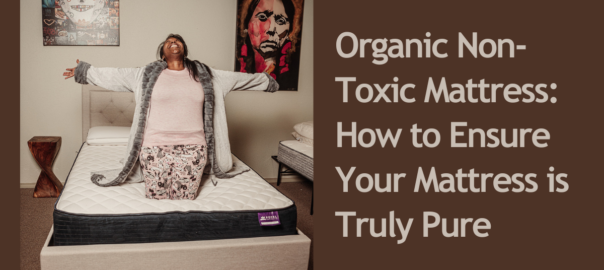With the increasing awareness of health and environmental concerns, many people are opting for organic mattresses to create a safer sleep environment. However, not all mattresses labeled as “organic” or “natural” are genuinely free from harmful chemicals. Many brands use misleading marketing tactics, making it difficult to verify the actual purity of a mattress.
In this guide, we’ll walk you through the essential factors to consider when purchasing an organic non-toxic mattress. From certifications to material transparency, you’ll gain the knowledge needed to make an informed choice for better indoor air quality and a healthier night’s sleep.
Why Mattress Purity Matters
The Impact on Indoor Air Quality and Health
Traditional mattresses are often made with polyurethane foam, synthetic latex, and conventional cotton, which may contain volatile organic compounds (VOCs), chemical fire retardants, formaldehyde, and other toxic substances. Over time, these chemicals can off-gas into the air, affecting indoor air quality and potentially causing:
- Respiratory issues
- Skin irritation and allergies
- Headaches and dizziness
- Long-term health risks, such as nervous system damage or increased cancer risk
In contrast, organic mattresses use safer, organic materials such as organic cotton, natural latex (sourced from rubber trees), and organic wool. These materials minimize chemical exposure, improving indoor air quality and providing a safer sleeping surface.
Beware of Greenwashing: Misleading Marketing Claims
Many mattress brands use deceptive tactics, often called greenwashing, to make their products appear more natural or eco-friendly than they actually are. Common tactics include:
✔ Vague Claims: Phrases like “eco-friendly” or “natural” without proof of certifications or material sourcing.
✔ Partial Truths: A mattress labeled as having natural latex but only containing a small portion of it, while the rest is synthetic.
✔ Misleading Certifications: Some companies create their own “certifications” to mislead customers, rather than being tested for harmful substances by reputable third-party organizations.
To avoid falling for greenwashing, it’s crucial to check third-party certifications and research the materials used in the mattress.
How to Verify the Purity of an Organic Mattress
1. Look for Trusted Certifications
Reliable mattress brands provide third-party certifications that confirm the product has been tested for harmful substances and meets organic and environmental standards. Some of the most recognized certifications include:
- Global Organic Textile Standard (GOTS) – Ensures that organic cotton and other fibers are organically produced and processed under environmentally and socially responsible conditions.
- Global Organic Latex Standard (GOLS) – Certifies that natural latex derived from rubber trees meets strict organic requirements.
- OEKO-TEX® Standard 100 – A globally recognized certification ensuring that every component of a mattress, including fabric, thread, and accessories, is tested for harmful substances.
- GREENGUARD Gold Certification – Guarantees that the mattress has low chemical emissions and meets rigorous safety standards for indoor air quality.
A truly organic non-toxic mattress will carry at least one or more of these certifications, proving its purity.
2. Examine the Materials Used
A high-quality organic mattress should be made with organic materials that are free from polyurethane foam, synthetic latex, and toxic adhesives. Look for:
✔ Organic Cotton – Free from pesticides, herbicides, and synthetic processing chemicals.
✔ Natural Latex – Harvested from rubber trees and certified under Global Organic Latex Standard (GOLS) to ensure purity.
✔ Organic Wool – Naturally flame-resistant and free from chemical fire retardants.
Avoid mattresses that use vague terms like “eco-friendly foam” or “natural blend” without specifying the exact composition.
How to Read Mattress Labels for Transparency
Did you know that every mattress has a law tag that lists the materials used in its construction? These labels provide insight into whether a mattress contains synthetic or organic materials.
When reading a mattress tag, look for:
- 100% Organic Cotton instead of generic “cotton” (which could be chemically treated).
- 100% Natural Latex instead of “latex blend” (which often contains synthetic latex).
- Organic Wool instead of “wool blend” (which may be mixed with synthetic fibers).
Checking the law tag ensures you’re getting a mattress made from genuine organic materials, rather than one that only has a small organic component.
Choosing a Trustworthy Mattress Brand
Transparency Matters
The best mattress brands openly disclose their materials, certifications, and sourcing practices. When researching brands, ask:
✔ Do they provide third-party certifications?
✔ Do they list every material used, including foam types and adhesives?
✔ Are they responsive to customer inquiries about material purity?
If a company refuses to disclose information or uses vague claims, it’s a red flag that the mattress may not be truly organic.
Take the First Step Toward Healthier Sleep!
Investing in an organic non-toxic mattress improves your sleep environment and overall well-being by reducing exposure to harmful chemicals and improving indoor air quality. By verifying the mattress through trusted certifications, inspecting materials, and researching mattress brands, you can ensure you’re making a safe and sustainable choice.
Frequently Asked Questions
1. What is the safest mattress material?
The safest mattress materials include organic cotton, natural latex (from rubber trees), and organic wool, as they are free from harmful chemicals and synthetic additives.
2. What does GREENGUARD Gold Certification mean?
This certification ensures that a product has been tested for harmful substances and meets strict emission standards for volatile organic compounds (VOCs), improving indoor air quality.
3. Why should I avoid polyurethane foam?
Polyurethane foam is derived from petroleum and often contains flame retardants, VOCs, and other harmful chemicals that may off-gas into the air, affecting sleep quality and health.
4. Are all natural latex mattresses organic?
Not necessarily. Some mattresses labeled as “natural latex” contain a mix of synthetic and natural materials. Look for Global Organic Latex Standard (GOLS) certification to ensure purity.

